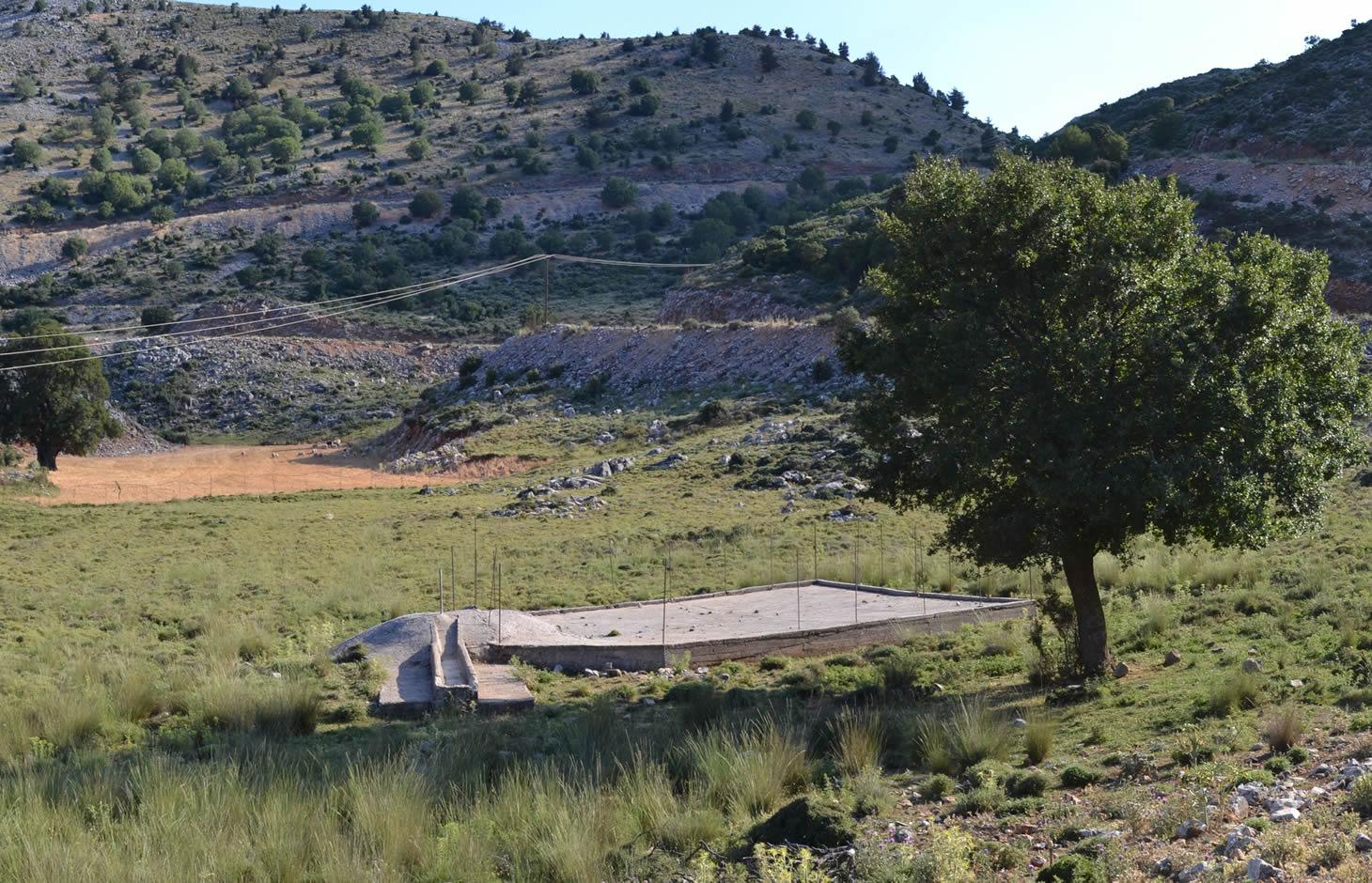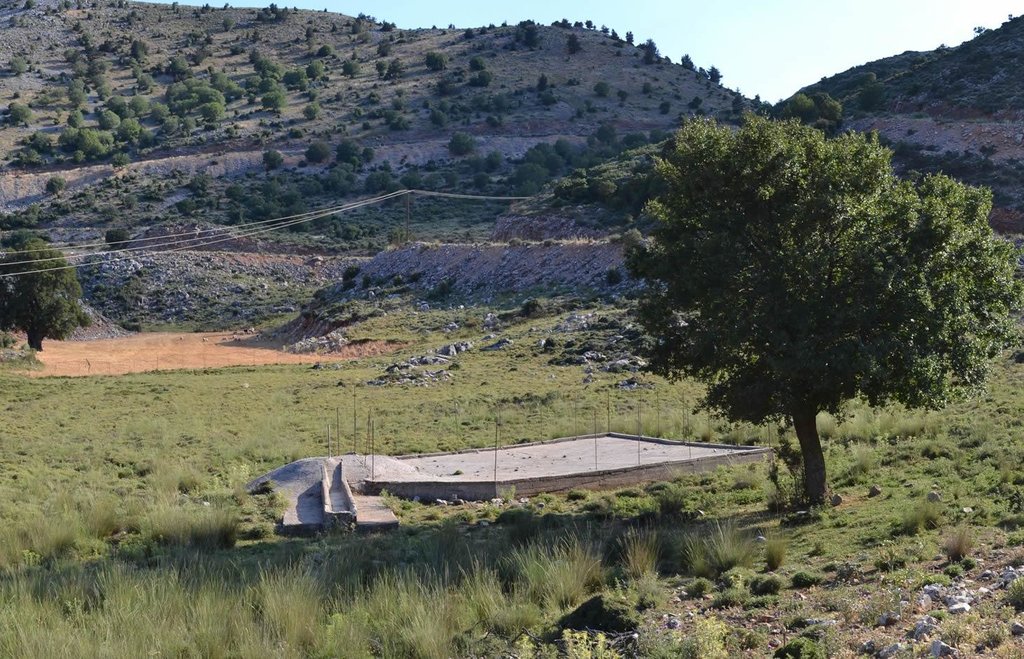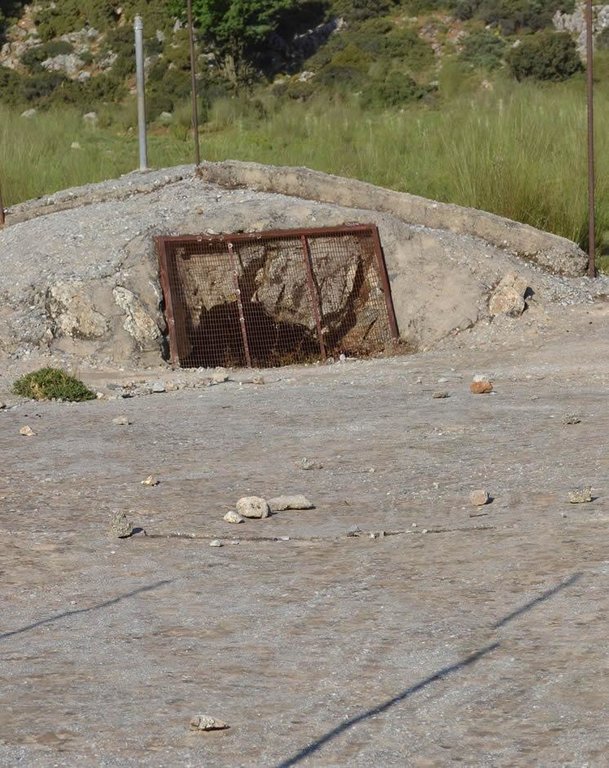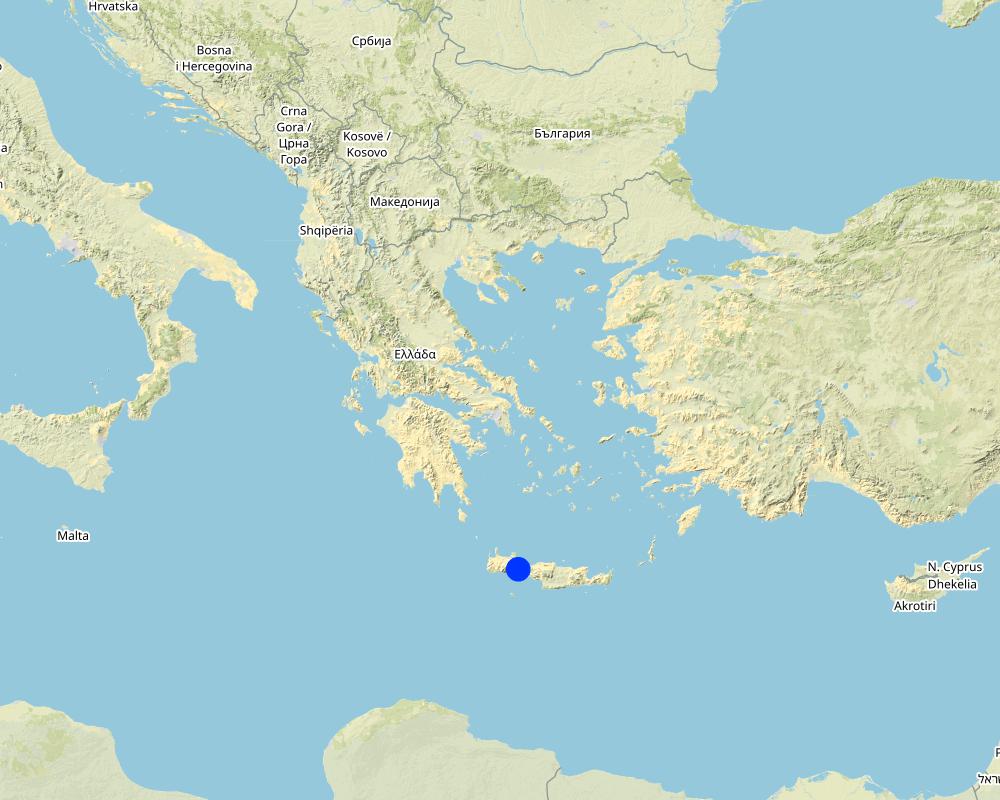Integrated water-harvesting and livestock water-point system [Грек]
- Шинийг нээх:
- Шинэчлэх:
- Эмхэтгэгч: Ioannis Daliakopoulos
- Хянан тохиолдуулагч: –
- Хянагчид: Alexandra Gavilano, Fabian Ottiger, Joana Eichenberger
Συνδυασμένο σύστημα συγκομιδής ομβρίων υδάτων και ποτίσματος αιγοπροβάτων
technologies_1206 - Грек
Бүлгүүдийг үзэх
Бүгдийг дэлгэх Бүгдийг хаах1. Ерөнхий мэдээлэл
1.2 Технологийг үнэлэх, баримтжуулах ажилд хамаарах мэдээлэл өгсөн хүмүүс, байгууллагуудын холбоо барих мэдээлэл
ГТМ мэргэжилтэн:
ГТМ мэргэжилтэн:
Tsanis Ioannis
Technical University of Crete
Грек
Технологи баримтжуулах/үнэлэх ажилд дэмжлэг үзүүлсэн төслийн нэр (шаардлагатай бол)
Catastrophic shifts in drylands (EU-CASCADE)Технологи баримтжуулах/үнэлэх ажилд дэмжлэг үзүүлсэн байгууллага(ууд)-ын нэр (шаардлагатай бол)
Technical University of Crete (Technical University of Crete) - Грек1.3 ВОКАТ-аар баримтжуулсан өгөгдлийг ашиглахтай холбоотой нөхцөл
Эмхэтгэгч болон гол мэдээлэгч хүн(хүмүүс) WOCAT аргачлалаар баримтжуулсан мэдээллийг ашиглахтай холбоотой нөхцлийг хүлээн зөвшөөрсөн:
Тийм
2. ГТМ Технологийн тодорхойлолт
2.1 Технологийн товч тодорхойлолт
Технологийн тодорхойлолт:
Integration of a cement pan and collection well system for water harvesting and a trough serving as a livestock water point.
2.2 Технологийн дэлгэрэнгүй тодорхойлолт
Тодорхойлолт:
An area of around 100 m<sup>2</sup> built out of cement or similar impermeable material forms an artificial watershed that drains into a well or tank, depending on landscape slope and system configuration. The well/tank, also made of cement to reduce losses due to infiltration, is covered in order to prevent water evaporation during the dry season. Its size depends on configuration and is ca. 40 m<sup>3</sup>. A detachable pumping system is used to draw water into a trough that is part of the permanent structure in a convenient location of the well or pan. The quality of water is maintained by keeping the collection area isolated from livestock using a removable chain-link fence placed on permanent metal poles. A grate is also installed at the opening of the well/tank to filter debris.
Purpose of the Technology: This system is installed in remote locations with poor access to fresh water. The water harvesting system collects water during the winter rains and snowfalls for use during the dry season. The trough of the system serves as a watering point for the user's livestock. This way the user can reduce the need of water transportation for his livestock, usually involving additional labor and transportation costs.
Besides the practical use of the water harvesting system, several functions are served with this installation. The existence of a source of soil moisture can cause a marked change in an otherwise very dry environment. Frequently these structures are jointly owned thus creating a sense of community among pastoralists.
Establishment / maintenance activities and inputs: Depending on initial slope, the water storage structure is designed. In relatively flat areas a well is dug and lined, whereas steeper slopes can be profited from by building part of the collection structure above ground. The later solution has a reduced cost and may also allow water extraction with natural flow. The technology can also be applied to extend the use of traditional wells by adding the rest of the structures. Exact sizing can be specified to allow storage of 10-20% over the average wet season precipitation in the area. After slope preparation, the collection structure, cement watershed and trough are constructed. The system is best established during autumn where temperature extremes that can make concrete curing difficult are less frequent. During the dry season, water can be extracted either by natural flow or a vacuum pump and channeled directly into the water point. Typically the cement structure and pumping system require little maintenance.
Natural / human environment: The harvesting system is best installed where the annual precipitation amount is sufficient but availability is hindered by seasonality, i.e. little natural storage exists and dry seasons yield little or no precipitation. The system is also most useful in remote locations with little or no access to water. Nevertheless, for the systems that require mechanical pumping, the location needs to be accessible by utility vehicle carrying relevant equipment and power supply.
2.3 Технологийн гэрэл зураг
2.5 Энэ үнэлгээнд хамрагдсан технологийг хэрэгжүүлсэн улс орон/ бүс нутаг/ байршил
Улс:
Грек
Улс/аймаг/сум:
Chania
Байршлын дэлгэрэнгүй тодорхойлолт:
Askifou
Тайлбар:
Total area covered by the SLM Technology is 0.03 km2.
Map
×2.6 Хэрэгжсэн хугацаа
Байгуулсан тодорхой оныг мэдэхгүй бол баримжаа хугацааг тодорхойл:
- 10-50 жилийн өмнө
2.7 Технологийн танилцуулга
Технологийг хэрхэн нэвтрүүлснийг тодорхойл:
- Гадны төсөл/хөтөлбөрийн дэмжлэгтэйгээр
Тайлбар (төслийн төрөл г.м.):
The storage of the specific water harvesting system is part of a traditional well constructed around 1870 and the rest of the structures where added during the 90s though initiatives of the municipality.
3. ГТМ технологийн ангилал
3.1 Технологийн үндсэн зорилго (ууд)
- үйлдвэрлэлийг сайжруулах
3.2 Технологи нэвтрүүлсэн газрын одоогийн газар ашиглалтын хэлбэр(үүд)

Бэлчээрийн газар
Бэлчээрийн мал аж ахуй:
- Нүүдлийн мал аж ахуй
- Хагас нүүдлийн бэлчээрийн аж ахуй
Амьтдын төрөл зүйл:
- ямаа
- хонь
Тайлбар:
Number of growing seasons per year: 1
Longest growing period in days: 298Longest growing period from month to month: 271-353
Livestock density: 50-100 LU /km2
Major land use problems (compiler’s opinion): precipitation seasonal variability causing water availability shortage during dry summers
Semi-nomadism / pastoralism: sheep/ goats
3.4 Усан хангамж
Технологи хэрэгжүүлсэн газрын усан хангамж:
- Байгалийн усалгаатай
3.5 Технологи ГТМ-ийн аль бүлэгт хамаарах вэ
- Ус хуримтлуулах
3.6 Технологийг бүрдүүлэх ГТМ арга хэмжээ

Барилга байгууламжийн арга хэмжээ
- S5: Далан, усан сан, цөөрөм
- S11: Бусад
Тайлбар:
Main measures: structural measures
Specification of other structural measures: well and watering point
3.7 Технологид харгалзах газрын доройтлын төрөл

усны доройтол
- Ha: Хуурайшилт
- Hs: Гадаргын усны хэмжээ багасах
Тайлбар:
Main type of degradation addressed: Ha: aridification
Secondary types of degradation addressed: Hs: change in quantity of surface water
Main causes of degradation: droughts
3.8 Газрын доройтлоос урьдчилан сэргийлэх, сааруулах ба нөхөн сэргээх
Газрын доройтолтой холбоотойгоор Технологи ямар зорилго тавьсан болохыг тодорхойл:
- газрын доройтлоос урьдчилан сэргийлэх
- Газрын доройтлыг бууруулах
Тайлбар:
Main goals: mitigation / reduction of land degradation
Secondary goals: prevention of land degradation
4. Техникийн нөхцөл, хэрэгжүүлсэн үйл ажиллагаа, материал ба зардал
4.1 Технологийн техник зураг
Техник тодорхойлолт (техник зургийн тайлбар):
The collection area, lined with cement, drains into the well through the collection point. A removable chain-link fence keeps the collection area isolated from livestock. A detachable pumping system can be connected to the pump installation point in order to supply the livestock water point with water from the well.
Date: 2/9/2014
Technical knowledge required for field staff / advisors: moderate
Technical knowledge required for land users: low
Main technical functions: water harvesting / increase water supply
Structural measure: well
Depth of ditches/pits/dams (m): 5
Width of ditches/pits/dams (m): 3
Length of ditches/pits/dams (m): 3
Structural measure: collection area
Depth of ditches/pits/dams (m): 0.1
Width of ditches/pits/dams (m): 10
Length of ditches/pits/dams (m): 10
Structural measure: watering point
Depth of ditches/pits/dams (m): 0.2
Width of ditches/pits/dams (m): 1
Length of ditches/pits/dams (m): 5
Structural measure: fencing
Height of bunds/banks/others (m): 1.5
Length of bunds/banks/others (m): 40
Specification of dams/ pans/ ponds: Capacity 40m3
Catchment area: 100m2
Зохиогч:
I. Daliakopoulos
4.2 Материал болон зардалд хамаарах ерөнхий мэдээлэл
бусад/үндэсний мөнгөн нэгж (тодорхойл):
euro
Хэрэв боломжтой бол үндэсний валютын Америк доллартай харьцах харьцааг бичнэ үү (тухайлбал, 1 ам.дол. = 79,9 Бразил реал): 1 ам.дол. =:
0.77
4.3 Бий болгох үйл ажиллагаа
| Үйл ажиллагаа | Хугацаа (улирал) | |
|---|---|---|
| 1. | Field preparation | |
| 2. | Well digging | |
| 3. | Building of cement well cover | |
| 4. | Laying of concrete pan for water/snow collection | Installation |
| 5. | Installation of pumping tube | |
| 6. | Installation of cement watering point | |
| 7. | Fence installation | |
| 8. | Pump acquisition |
4.4 Бий болгоход шаардагдсан зардал, хөрөнгийн өртөг
| Зардлын нэр, төрөл | Хэмжих нэгж | Тоо хэмжээ | Нэгжийн үнэ | Зардал бүрийн нийт өртөг | Нийт дүнгээс газар ашиглагчийн төлсөн % | |
|---|---|---|---|---|---|---|
| Хөдөлмөр эрхлэлт | Labour | Dam | 1.0 | 2865.0 | 2865.0 | 100.0 |
| Тоног төхөөрөмж | Machine use | Dam | 1.0 | 580.0 | 580.0 | 100.0 |
| Барилгын материал | Chain-link fence | Dam | 1.0 | 325.0 | 325.0 | 100.0 |
| Барилгын материал | Concrete | Dam | 1.0 | 3270.0 | 3270.0 | 100.0 |
| Барилгын материал | Cement pipes | Dam | 1.0 | 1940.0 | 1940.0 | 100.0 |
| Барилгын материал | Pum | Dam | 1.0 | 390.0 | 390.0 | 100.0 |
| Технологи бий болгох нийт үнэ өртөг | 9370.0 | |||||
| Технологи бий болгох нийт үнэ өртөг, ам.доллар | 12168.83 | |||||
4.5 Арчилгаа/ урсгал үйл ажиллагаа
| Үйл ажиллагаа | Хугацаа/ давтамж | |
|---|---|---|
| 1. | Pump maintenance | once a year |
4.6 Арчилгаа/урсгал ажилд шаардагдсан зардал, хөрөнгийн өртөг (нэг жилд)
| Зардлын нэр, төрөл | Хэмжих нэгж | Тоо хэмжээ | Нэгжийн үнэ | Зардал бүрийн нийт өртөг | Нийт дүнгээс газар ашиглагчийн төлсөн % | |
|---|---|---|---|---|---|---|
| Хөдөлмөр эрхлэлт | Labour | Dam | 1.0 | 50.0 | 50.0 | |
| Технологийн арчилгаа/урсгал үйл ажиллагаанд шаардагдах нийт үнэ өртөг | 50.0 | |||||
| Технологи арчилах ба урсгал ажлын нийт үнэ өртөг, ам.доллар | 64.94 | |||||
Тайлбар:
Costs were calculated for the construction of a well in 2014 for an easily accessible location. Nevertheless, the specific system is built around a traditional well thus its actual cost was lower.
4.7 Зардалд нөлөөлж байгаа хамгийн чухал хүчин зүйл
Өртөг, зардалд нөлөөлөх гол хүчин зүйл:
Costs mainly depend on the well/tank contraction and the accessibility of the construction area (slope, proximity to road network, etc.)
5. Байгаль ба нийгмийн нөхцөл
5.1 Уур амьсгал
Жилийн нийлбэр хур тундас
- < 250 мм
- 251-500 мм
- 501-750 мм
- 751-1,000 мм
- 1,001-1,500 мм
- 1,501-2,000 мм
- 2,001-3,000 мм
- 3,001-4,000 мм
- > 4,000 мм
Хур тунадасны талаархи тодорхойлолт/ тайлбар:
Winter rains
Агро-уур амьсгалын бүс
- чийглэг
- хагас хуурай
Thermal climate class: subtropics
5.2 Гадаргын хэлбэр
Дундаж налуу:
- хавтгай (0-2 %)
- бага зэрэг налуу (3-5 %)
- дунд зэрэг налуу (6-10 % )
- хэвгий (11-15 %)
- налуу (16-30 %)
- их налуу (31-60 % )
- эгц налуу (>60 %)
Гадаргын хэлбэр:
- тэгш өндөрлөг / тал
- нуруу
- уулын энгэр
- дов толгод
- бэл
- хөндий
Өндрийн бүслүүр:
- 0-100 д.т.д. м.
- 101-500 д.т.д. м.
- 501-1,000 д.т.д м.
- 1,001-1,500 д.т.д м.
- 1,501-2,000 д.т.д м.
- 2,001-2,500 д.т.д. м.
- 2,501-3,000 д.т.д. м.
- 3,001-4,000 д.т.д м.
- > 4,000 д.т.д. м.
Гадаргын талаархи тодорхойлолт ба бусад тайлбар:
Landforms: On hill slopes configuration may differ, may not require pumping equipment
Slopes on average: Hilly (16-30%) configuration may change, may not require pump
5.3 Хөрс
Хөрсний дундаж зузаан:
- маш нимгэн (0-20 см)
- нимгэн (21-50 см)
- дунд зэрэг зузаан (51-80 см)
- зузаан (81-120 cм)
- маш зузаан (>120 cм)
Хөрсний бүтэц (өнгөн хөрс):
- дундаж (элсэнцэр, шавранцар)
Өнгөн хөрсөнд агуулагдах ялзмаг:
- бага (<1 % )
Боломжтой бол хөрсний бүрэн тодорхойлолт, боломжит мэдээллийг өгнө үү, жишээ нь хөрсний төрөл, хөрсний урвалын орчин/хүчиллэг байдал, катион солилцох чадавхи, азотын хэмжээ, давсжилт г.м.
Soil fertility is low
Soil drainage/infiltration is medium
Soil water storage capacity is very low
5.4 Усны хүртээмж ба чанар
Гүний усны түвшин:
> 50 м
Гадаргын усны хүртээмж:
хангалтгүй/ байхгүй
Усны чанар (цэвэршүүлээгүй):
сайн чанарын ундны ус
5.5 Биологийн олон янз байдал
Зүйлийн олон янз байдал:
- дунд зэрэг
5.6 Технологи нэвтрүүлсэн газар ашиглагчдын тухай мэдээлэл
Үйлдвэрлэлийн системийн зах зээлийн чиг баримжаа:
- худалдаа наймааны/ зах зээлийн
Бусад эх үүсвэрээс олох орлого:
- Нийт орлогын 10-50 %
Чинээлэг байдлын түвшин:
- ядуу
- дундаж
Хувь хүн эсвэл бүлэг:
- бүлэг / олон нийтийн
Хүйс:
- эрэгтэй
Газар ашиглагчдын бусад шинж чанарыг тодорхойл:
Land users applying the Technology are mainly common / average land users
Population density: < 10 persons/km2
Annual population growth: 0.5% - 1%
5.7 Газар ашиглагчийн технологи нэвтрүүлсэн газрын дундаж талбайн хэмжээ
- < 0.5 га
- 0.5-1 га
- 1-2 га
- 2-5 га
- 5-15 га
- 15-50 га
- 50-100 га
- 100-500 га
- 500-1,000 га
- 1,000-10,000 га
- > 10,000 га
Энэ талбай том, жижиг, дунд алинд хамаарах вэ (орон нутгийн нөхцөлд харгалзуулна уу)?
- дунд-хэмжээний
Тайлбар:
Average area of land owned or leased by land users applying the Technology: 5-15 ha, 15-50 ha, 50-100 ha
5.8 Газар эзэмшил, газар ашиглах эрх, ус ашиглах эрх
Газар өмчлөл:
- хувь хүн, өмчийн гэрчилгээгүй
- хувь хүн, өмчийн гэрчилгээтэй
5.9 Дэд бүтэц, үйлчилгээний хүртээмж
эрүүл мэнд:
- ядуу
- дунд зэргийн
- сайн
боловсрол:
- ядуу
- дунд зэргийн
- сайн
техник зөвлөгөө:
- ядуу
- дунд зэргийн
- сайн
хөдөлмөр эрхлэлт (жишээ нь, ХАА-аас өөр):
- ядуу
- дунд зэргийн
- сайн
зах зээл:
- ядуу
- дунд зэргийн
- сайн
эрчим хүчний хангамж:
- ядуу
- дунд зэргийн
- сайн
зам тээвэр:
- ядуу
- дунд зэргийн
- сайн
усан хангамж ба ариутгал:
- ядуу
- дунд зэргийн
- сайн
санхүүгийн үйлчилгээ:
- ядуу
- дунд зэргийн
- сайн
6. Үр нөлөө ба дүгнэлт
6.1 Технологийн талбайд үзүүлсэн нөлөө
Нийгэм-эдийн засгийн үр нөлөө
Үйлдвэрлэл
бүтээмж буурах эрсдэл
газрын менежмент
Усны хүртээмж ба чанар
мал услах усны хүрэлцээ
мал услах усны чанар
Орлого, зарлага
ажлын хэмжээ
Тайлбар/ тодорхой дурьдах:
Water does not have to be transported to distant locations
Нийгэм-соёлын үр нөлөө
хүнсний аюулгүй байдал/ өөрийн хэрэгцээг хангах
маргааныг шийдвэрлэх
Improved livelihoods and human well-being
Тайлбар/ тодорхой дурьдах:
Expansive grazing and the form of transhumance practiced Crete requires a huge commitment of human capital. The transportation of water or ensuring water availability between or close to grazing grounds is an essential need of the livestock, especially during dry years. This technology contributes to the reduction of workload and to rendering transhumance more manageable.
Экологийн үр нөлөө
Усны эргэлт/ илүүдэл
усны хэмжээ
ус хураах / цуглуулах
Хөрс
хөрсний чийг
6.3 Технологийн уур амьсгалын өөрчлөлт, цаг агаарын гамшигт үзэгдэлд өртөх байдал ба эмзэг байдал (газар ашиглагчийн бодлоор)
Уур амьсгалын аажим өөрчлөлт
Уур амьсгалын аажим өөрчлөлт
| Улирал | Өсөх эсвэл буурах | Технологи түүний нөлөөг хэрхэн бууруулж байна? | |
|---|---|---|---|
| жилийн дундаж температур | Өсөлт | сайн |
Уур амьсгалаас хамаарах аюул (гамшиг)
Цаг уурын гамшигт үзэгдэл
| Технологи түүний нөлөөг хэрхэн бууруулж байна? | |
|---|---|
| орон нутгийн аадар бороо | сайн |
| орон нутгийн салхин шуурга | сайн |
Уур амьсгалын гамшиг
| Технологи түүний нөлөөг хэрхэн бууруулж байна? | |
|---|---|
| ган гачиг | сайн |
Усзүйн гамшиг
| Технологи түүний нөлөөг хэрхэн бууруулж байна? | |
|---|---|
| усны үер (гол) | сайн |
Уур амьсгалд хамаарах бусад үр дагавар
Уур амьсгалд хамаарах бусад үр дагавар
| Технологи түүний нөлөөг хэрхэн бууруулж байна? | |
|---|---|
| цргалтын хугацаа багасах | сайн |
6.4 Өртөг ба ашгийн шинжилгээ
Бий болгох зардалтай харьцуулахад ямар ашиг өгсөн бэ (газар ашиглагчийн бодлоор)?
Богино хугацаанд эргэн төлөгдөх байдал:
сөрөг
Урт хугацаанд эргэн төлөгдөх байдал:
эерэг
Арчилгаа/урсгал зардалтай харьцуулахад ямар ашиг өгсөн бэ (газар ашиглагчийн бодлоор)?
Богино хугацаанд эргэн төлөгдөх байдал:
эерэг
Урт хугацаанд эргэн төлөгдөх байдал:
эерэг
Тайлбар:
Initially, installation costs produce negative returns. Nevertheless the system requires little maintenance and the benefits emerge very soon, even after the first winter when the well has stored rain and snow water. As fuel expenses and human capital commitment for the transportation of water are significant, benefits predominate establishment costs within 2-3 years and maintenance / recurrent costs from the first year.
6.5 Технологи нэвтрүүлэлт
Боломжтой бол, тоогоор илэрхийл (өрхийн тоо эсвэл бүрхэх талбай):
3
Тайлбар:
3 land user families have adopted the Technology with external material support
Comments on acceptance with external material support: The current trend is that traditional wells are converted to an integrated water harvesting system with external support from the municipality, thus foregoing the well construction costs.
There is a little trend towards spontaneous adoption of the Technology
6.7 Технологийн давуу тал/боломжууд
| Газар ашиглагчдын тодорхойлсон давуу тал/боломжууд |
|---|
|
Decreases workload and costs during the dry season. How can they be sustained / enhanced? Workload and overall costs can be enhanced by increasing the density of water harvesting systems. |
| Эмхэтгэгч, бусад мэдээлэл өгсөн хүмүүсийн өнцгөөс тодорхойлсон давуу тал/боломжууд |
|---|
|
Increases water availability for livestock during the dry season, promotes sustainable grazing. How can they be sustained / enhanced? Water availability can be sustained by promoting sustainable management of other grazing practices, e.g. maintaining a healthy LU/area ratio. |
| The system is decentralised and requires little maintenance. |
7. Ном зүй ба холбоосууд
7.1 Мэдээлэл цуглуулсан арга/эх үүсвэр
Холбоос ба модулууд
Бүгдийг дэлгэх Бүгдийг хаахХолбоосууд
Холбоос байхгүй байна
Модулууд
Модуль байхгүй байна





